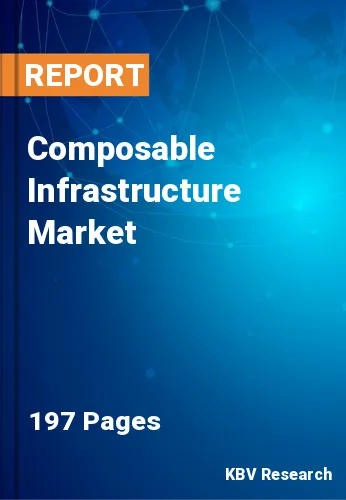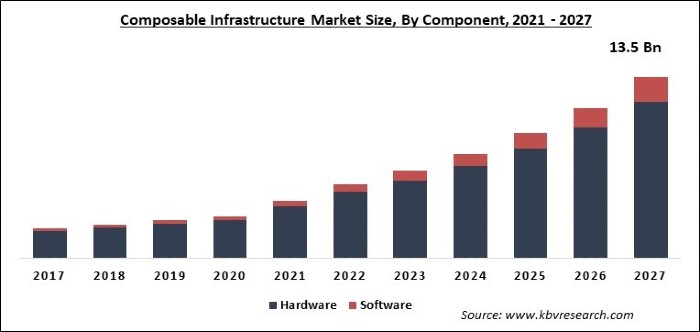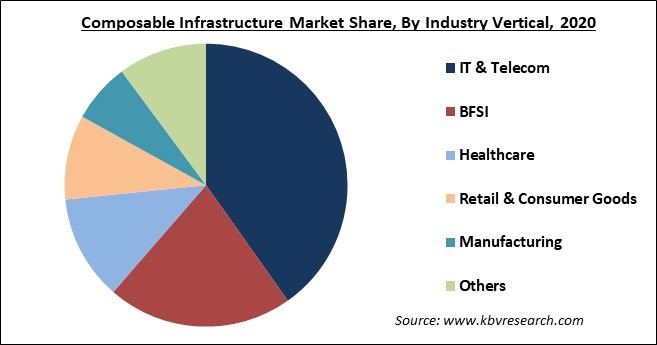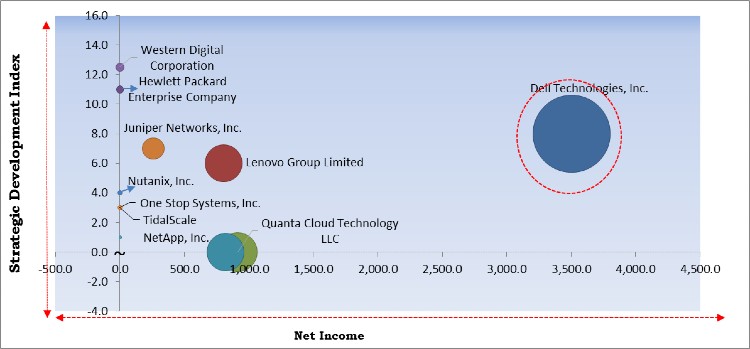
The Global Composable Infrastructure Market size is expected to reach $13.5 billion by 2027, rising at a market growth of 21% CAGR during the forecast period. Composable infrastructure is considered as a framework that separates device resources in order to use them as services. A composable infrastructure is an approach to data center architecture that separates high-performance applications and workloads from the primary hardware. It allows the company’s data center to use their hardware devices, software solution-based infrastructure and helps in reducing the time needed for the adoption of any other application for the same processes. It also provides the value addition to the businesses and then delivers increased competencies in infrastructure operations. In addition, CI also reduces operation expenditure eliminating different administration tools that demand a high-level understanding and expertise.
In the present scenario, several companies are evolving their security management by adopting composable infrastructure to manage their data instead of using private data centers or on-premises solutions. Though, they are facing some challenges while adopting skilled IT professionals or experts and other IT solutions, which offer the same visibility and control on the place of on-premises solutions. Therefore, it is estimated that these factors will hamper the growth of the composable infrastructure market. Whereas, a significant increase in investments in data center technologies and the development of the hybrid cloud are offering lucrative opportunities for global market growth.

The outbreak of the COVID-19 pandemic has compelled the government of various nations like India, China, the UK, the US, and Germany to impose regulations to follow the covid guidelines properly and lockdown in these countries forced employees to work from home or remote locations. Employees have easy access to the data at remote locations through the public cloud. Hence, on-premise storage systems and public cloud storage helped employees by making their work synchronized and tasks easier. Many companies have realized that this working style is very beneficial and have decided to extend the duration of work from home, which is attributed to a surge in the demand for composable infrastructure.
During the pandemic, technology providers were pushing companies across all potential industries by offering modern composable infrastructure solutions. Companies were struggling to maintain continuity in their business and at that time adoption of composable infrastructure helped them to achieve significant growth in their businesses. For example, First Technology Incorporation came into a strategic alliance with Hewlett Packard Enterprise that allows businesses to improve their present IT infrastructure during this pandemic.
In contrast with different and disconnected workflow-centric resources, the adoption of composable infrastructure offers a less complex environment in which a single infrastructure model is used across the organization. This helps in reducing the investment required for the staff training, a smaller number of silos of technical knowledge that mostly acts as a barrier in making changes, and providing a more open learning environment. In addition, composable infrastructure is a unique solution that supports constant IT service delivery.
Various applications have come into existence due to changes made in the traditional applications. The latest applications are now demanding IT to be more responsive. With the help of a template-driven approach, composable infrastructure is able to reduce provisioning time and make infrastructure resources available whenever required. This allows infrastructure to act as a strategic asset instead of hampering the growing rate of business.
The adoption of composable infrastructure is not a very difficult task whereas its implementation is the major challenge which is faced by various organizations. Its implementation requires skilled professionals and advanced technologies & devices. In addition, the employees need to be trained before implementing composable infrastructure, which is increasing the investment of the company. Additionally, the low amount of awareness among the developing companies is hampering the growth of the composable infrastructure market.
Based on Component, the market is segmented into Hardware and Software. The hardware segment acquired the highest revenue share in 2020. This segment comprises platforms and associated devices that are needed to improve IT infrastructure. The associated devices involve all on-premise systems like software licenses, database software, operating systems, racks, consoles, switches, keys, in-house data centers/servers, and other related hardware.

Based on Industry Vertical, the market is segmented into IT & Telecom, BFSI, Healthcare, Retail & Consumer Goods, Manufacturing and Others. The BFSI segment is anticipated to obtain the significant revenue share of the market during the forecasting period. The growth of the segment is augmented by the digital transformation. Financial institutions and banks generate and collect a huge volume of client’s data that is essential for the success of these institutes.
| Report Attribute | Details |
|---|---|
| Market size value in 2020 | USD 3.1 Billion |
| Market size forecast in 2027 | USD 13.5 Billion |
| Base Year | 2020 |
| Historical Period | 2017 to 2019 |
| Forecast Period | 2021 to 2027 |
| Revenue Growth Rate | CAGR of 21% from 2021 to 2027 |
| Number of Pages | 197 |
| Number of Tables | 284 |
| Report coverage | Market Trends, Revenue Estimation and Forecast, Segmentation Analysis, Regional and Country Breakdown, Competitive Landscape, Companies Strategic Developments, Company Profiling |
| Segments covered | Component, Industry Vertical, Region |
| Country scope | US, Canada, Mexico, Germany, UK, France, Russia, Spain, Italy, China, Japan, India, South Korea, Singapore, Malaysia, Brazil, Argentina, UAE, Saudi Arabia, South Africa, Nigeria |
| Growth Drivers |
|
| Restraints |
|
Based on Regions, the market is segmented into North America, Europe, Asia Pacific, and Latin America, Middle East & Africa. The Asia-Pacific composable infrastructure market is projected to witness the highest growth rate during the forecast period. The growing investment in smart city initiatives in the region is anticipated to augment the regional market growth. Further, the rapid increase in industrialization has led to the huge production of data, which is attributed to an increase in the demand for regional data storage management solutions.

Free Valuable Insights: Global Composable Infrastructure Market size to reach USD 13.5 Billion by 2027
The major strategies followed by the market participants are Product Launches. Based on the Analysis presented in the Cardinal matrix; Dell Technologies, Inc. is the major forerunners in the Composable Infrastructure Market. Companies such as One Stop Systems, Inc., Quanta Cloud Technology LLC, TidalScale are some of the key innovators in the market.
The market research report covers the analysis of key stake holders of the market. Key companies profiled in the report include Hewlett Packard Enterprise Company, NetApp, Inc., Dell Technologies, Inc., Lenovo Group Limited, Nutanix, Inc., Juniper Networks, Inc., Western Digital Corporation, TidalScale, Quanta Cloud Technology LLC (Quanta Computer, Inc.) and One Stop Systems, Inc.
By Component
By Industry Vertical
By Geography
The composable infrastructure market size is projected to reach USD 13.5 billion by 2027.
The growing number of businesses are surging the demand for composable infrastructure are driving the market in coming years, however, Less number of skilled professionals and a lack of awareness limited the growth of the market.
Hewlett Packard Enterprise Company, NetApp, Inc., Dell Technologies, Inc., Lenovo Group Limited, Nutanix, Inc., Juniper Networks, Inc., Western Digital Corporation, TidalScale, Quanta Cloud Technology LLC (Quanta Computer, Inc.) and One Stop Systems, Inc.
Many companies have realized that this working style is very beneficial and have decided to extend the duration of work from home, which is attributed to a surge in the demand for composable infrastructure.
The North America procured the maximum revenue share in 2020. The factors propelling the regional market growth are decreased capital expenditure and operational expenditure, owing to the deployment of composable infrastructure and the growing deployment of virtualization.
The IT and telecom segment dominated the market by acquiring the maximum revenue share in 2020. This growth is due to the existence of massive OTT vendors like Amazon Prime and Netflix.
Our team of dedicated experts can provide you with attractive expansion opportunities for your business.
